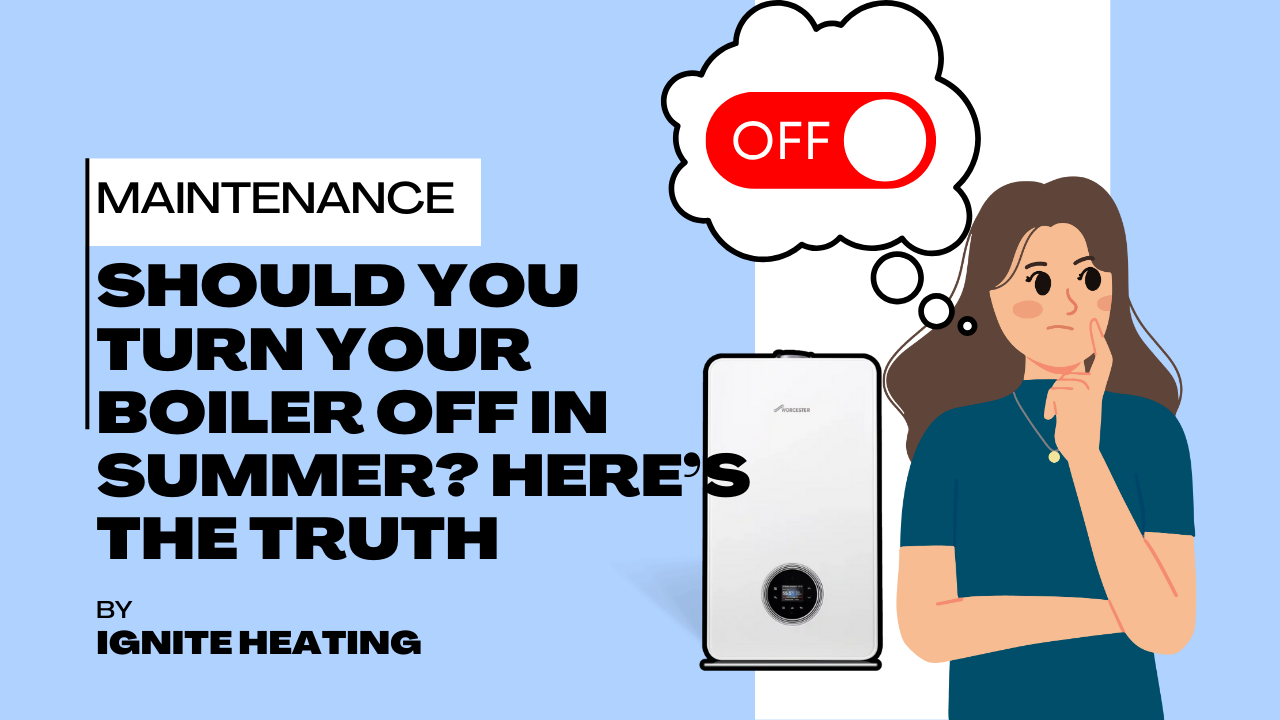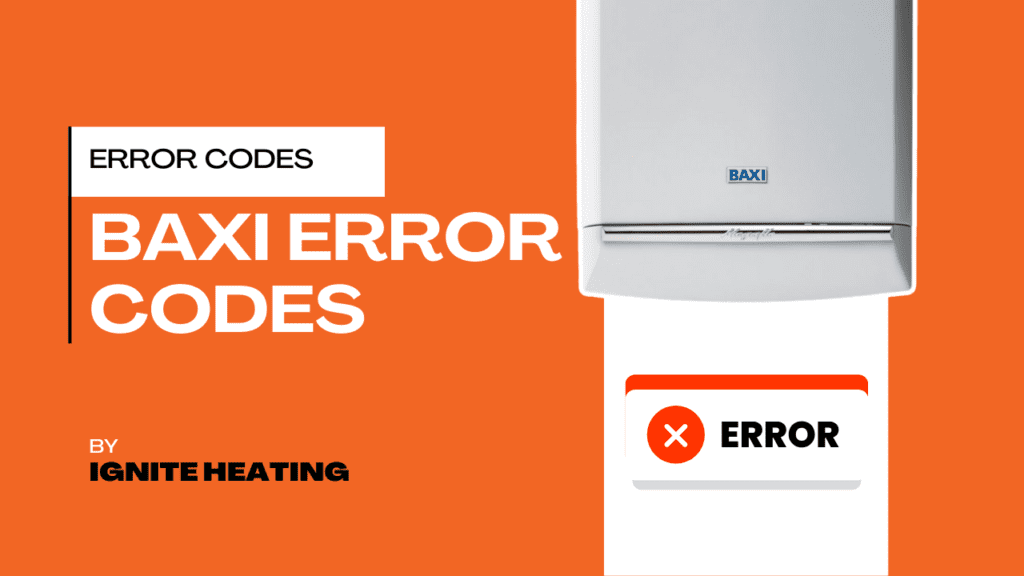
Should You Turn Your Boiler Off in Summer? Here’s the Truth.
Search Should You Turn Your Boiler Off in Summer? Here’s the Truth. Summer’s here finally. The sun’s shining (most days),

If you own a Baxi boiler, you may occasionally see an error code displayed on the control panel. These codes are designed to help diagnose problems quickly, allowing homeowners and engineers to identify faults and find the best solution. In this guide, we’ll walk you through some of the most common Baxi boiler error codes, what they mean, and how to fix them.

Baxi Platinum Compact Combi
Baxi Duo-tec Compact Combi
Baxi Megaflo Compact System
Main Eco Compact Combi & System
Baxi 600 Combi & System
Baxi 800 Combi & System
Baxi Duo-tec Combi
Baxi Assure Combi & System
Baxi Platinum Combi
Potterton Assure Combi & System
Baxi Platinum + Combi
Baxi Megaflo System
Baxi EcoBlue Combi & System
Cause: Fault in the gas valve connection.
Solution: Check the gas valve wiring and connection integrity.
Cause: External temperature probe issue.
Solution: Inspect and replace the faulty external probe if necessary.
Cause: Water flow switch remains open.
Solution: Check for blockages and ensure the switch is functioning properly.
Cause: Water flow switch remains closed.
Solution: Inspect and replace if necessary.
Cause: Faulty gas valve command.
Solution: Verify gas valve operation and control board connections.
Cause: Malfunctioning NTC sensor.
Solution: Replace the NTC sensor.
Cause: Faulty flue temperature sensor.
Solution: Inspect the wiring and replace the sensor if needed.
Cause: Defective return NTC sensor.
Solution: Check and replace the sensor if required.
Cause: Malfunction in DHW sensor.
Solution: Inspect and replace the sensor.
Cause: Communication failure between components.
Solution: Inspect wiring and ensure all connections are secure.
Cause: Low battery in safety assist system.
Solution: Replace the battery.
Cause: Malfunctioning PCB.
Solution: Replace the safety assist PCB.
Cause: PCB communication failure.
Solution: Reset the system or replace the PCB if necessary.
Cause: Circulation failure.
Solution: Check the pump and system circulation.
Cause: Possible pump failure or airlock in the system.
Solution: Bleed radiators, check pump operation, and reset the boiler.
Cause: Insufficient system pressure.
Solution: Repressurise using the filling loop.
Cause: Blockage, airlock, or pump failure.
Solution: Bleed radiators, check for blockages, and inspect the pump.
Cause: Unstable flame detection.
Solution: Inspect gas supply, flame sensor, and ignition electrodes.
Cause: Ignition failure.
Solution: Check ignition components and reset the system.
Cause: Overheating flue gases.
Solution: Inspect the flue and ensure proper ventilation.
Cause: Issue with gas valve operation.
Solution: Inspect and replace the gas valve if necessary.
Cause: Unknown internal fault.
Solution: Contact a Gas Safe engineer.
Cause: Mismatch in flow/return temperatures.
Solution: Check circulation and system balance.
Cause: Malfunctioning fan.
Solution: Inspect and replace the fan if required.
Cause: Boiler running without sufficient water.
Solution: Refill the system and check for leaks.
Cause: Electrical frequency mismatch.
Solution: Verify power supply specifications.
Cause: Faulty DHW sensor.
Solution: Replace the sensor.
Cause: Flame detection error.
Solution: Inspect flame sensor and ignition system.
Cause: Insufficient voltage supply.
Solution: Check electrical connections and supply.
Cause: Pressure fluctuation.
Solution: Monitor and stabilise pressure levels.
Cause: Incorrect water pressure reading.
Solution: Repressurise and reset the boiler.

Baxi 200 Combi 2
Baxi 400 Combi 2
Baxi 600 Combi 2
Baxi 800 Combi 2
Baxi Assure 500 Combi 2
Baxi 600 System 2
Baxi 800 System 2
Baxi Assure 500 System 2
Cause: Disconnected or faulty sensor.
Solution: Reconnect or replace the sensor.
Cause: Short circuit or excessive temperature.
Solution: Check the wiring and replace the sensor if necessary.
Cause: Missing or faulty sensor.
Solution: Ensure the sensor is installed and working properly.
Cause: Water loss or leak.
Solution: Refill the system and check for leaks.
Cause: Communication failure.
Solution: Restart the system and check connections.
Cause: Device unplugged or broken.
Solution: Reconnect or replace the device.
Cause: Wiring issue or sensor failure.
Solution: Inspect and reconnect the wiring.
Cause: Communication fault.
Solution: Check cables and connections.
Cause: Configuration issue.
Solution: Reset priority settings.
Cause: Incorrect settings.
Solution: Verify configuration parameters.
Cause: Startup issue.
Solution: Reboot the system and check connections.
Cause: Power failure.
Solution: Verify the power supply and replace components if needed.
Cause: Factory defect or configuration issue.
Solution: Re-enter or update the serial number.
Cause: Locked settings.
Solution: Factory reset or manufacturer assistance.
Cause: The return temperature sensor is not connected, possibly due to a loose or broken wire.
Solution: Check the wiring and connections of the return temperature sensor. Reconnect or replace the sensor if necessary.
Cause: A short circuit in the return temperature sensor is preventing accurate temperature measurement.
Solution: Inspect the sensor wiring for any visible damage. If the sensor is faulty, replace it.
Cause: The Domestic Hot Water (DHW) tank sensor is disconnected or faulty.
Solution: Ensure the sensor is properly connected. If the issue persists, replace the sensor.
Cause: A short circuit in the DHW tank temperature sensor.
Solution: Replace the sensor after verifying the wiring and connections.
Cause: The sensor is disconnected or measuring an abnormally low temperature.
Solution: Check sensor wiring and reconnect if needed. If the issue persists, replace the sensor.
Cause: The sensor has short-circuited or is detecting excessive temperatures.
Solution: Inspect the sensor wiring, and if necessary, replace the sensor.
Cause: Repeated flame loss due to gas supply issues or ignition failure
Solution: Check the gas supply, clean the burner, and inspect ignition components. If the issue continues, call a heating engineer.
Cause: Circulation issue or incorrect sensor readings.
Solution: Ensure proper water circulation and check for blockages or faulty sensors.
Cause: Pump failure, airlock, or blockage.
Solution: Check the pump operation, bleed the system, and remove any blockages.
Cause: Poor ventilation, clogged flue, or overheating burner.
Solution: Inspect and clean the flue, check ventilation, and ensure the burner operates efficiently.
Cause: The boiler has completely shut down due to freezing or a safety lockout.
Solution: Ensure the system is at a safe temperature. Reset the boiler or call an engineer.
Cause: Wiring issues, PCB failure, or faulty gas valve.
Solution: Check wiring connections and reset the boiler. Replace faulty components as needed.
Cause: Safety components like temperature or pressure sensors are disconnected.
Solution: Inspect and reconnect or replace the safety device.
Cause: Low system pressure, leak, or filling loop failure.
Solution: Check for leaks, repressurize the system, and inspect the filling loop.
Cause: Communication issue with an external control system.
Solution: Verify connections and settings of the external device.
Cause: The sensor has short-circuited.
Solution: Replace the faulty sensor.
Cause: The sensor is not connected.
Solution: Reconnect the sensor securely.
Cause: Overheating or sensor failure.
Solution: Check for system blockages and replace the sensor if required.
Cause: Overheating due to circulation problems.
Solution: Improve system circulation and check the pump.
Cause: Ignition failure due to gas or spark issues.
Solution: Check the gas supply, ignition electrodes, and flame sensor.
Cause: Flame detection issues.
Solution: Clean the flame sensor or replace it if faulty.
Cause: Obstructed fan or control failure.
Solution: Clean or replace the fan.
Cause: Gas valve control failure.
Solution: Inspect and replace the gas valve if needed.
Cause: Sensor failure or incorrect readings.
Solution: Reconnect or replace the sensor.
Cause: Internal PCB or software failure.
Solution: Reset the boiler and check the PCB connections.
Cause: Electrical failure in gas valve control similar to previous error codes.
Solution: Inspect the wiring, check for faulty connections, and replace the gas valve if necessary.
Cause: Electrical failure in gas valve control.
Solution: Inspect the wiring and replace the gas valve if necessary.
Cause: The pressure sensor is malfunctioning or disconnected.
Solution: Check for loose or damaged wiring. If the sensor is faulty, replace it.
Cause: The communication between the room thermostat and the boiler is lost.
Solution: Ensure the thermostat is powered and properly connected. If wireless, re-sync the devices.
Cause: A short-term disconnection between the gas valve and the PCB.
Solution: Reset the boiler and check the wiring connections. If the issue persists, an engineer should inspect the gas valve.
Cause: Blocked pipes, airlocks, or a faulty pump preventing proper water circulation.
Solution: Bleed radiators, check the pump operation, and inspect for blockages.
Cause: Restricted circulation or a faulty pump.
Solution: Allow the boiler to reset automatically. If recurring, check for blockages or replace the pump.
Cause: Blocked system, sensor issues, or excessive demand on the boiler.
Solution: Inspect and flush the system, check temperature sensors, and ensure the boiler is not oversized for the property.
Cause: Airlock, pump failure, or closed valves.
Solution: Bleed the system, ensure all valves are open, and check the pump functionality.
Cause: Blocked heat exchanger or sensor issues.
Solution: Clean or replace the heat exchanger and inspect the temperature sensors.
Cause: The boiler is in the process of resetting.
Solution: Wait for the reset to complete.
Cause: Boiler setup is incomplete.
Solution: Complete the initial setup following manufacturer instructions.
Cause: Incorrect installation settings.
Solution: Re-enter the settings correctly based on the boiler manual.
Cause: PCB failure or software corruption.
Solution: Reprogram or replace the PCB.
Cause: Incorrect PCB or software issue.
Solution: Ensure the correct PCB is installed and update firmware if needed.
Cause: Water leak, faulty pressure sensor, or airlock.
Solution: Check for leaks, repressurise the system, and inspect the pressure sensor.
Cause: Extremely low temperatures triggering antifreeze mode.
Solution: Allow the system to warm up naturally or adjust temperature settings.
Cause: Extreme cold preventing boiler operation.
Solution: Warm the area around the boiler, insulate pipes, and reset the system.
Cause: A fault in the external heat recovery system.
Solution: Contact a heating engineer for system inspection.
Cause: The boiler safety system is not recognized.
Solution: Reset the boiler; if unresolved, a service engineer should inspect the safety devices.
Cause: Gas supply issues or weak ignition.
Solution: Check the gas supply, ensure electrodes are clean, and inspect the flame sensor.
Cause: Insufficient electrical supply.
Solution: Check the main power supply and consult an electrician if needed.
Cause: Electrical fluctuations affecting ignition.
Solution: Use a voltage stabilizer or contact an electrician for a permanent fix.
Understanding these error codes can help you troubleshoot minor issues and determine when professional assistance is required. If your boiler displays an error code and you are unsure how to proceed, always consult your user manual or contact a Gas Safe registered engineer for assistance.
If you are struggling to find your error code or experiencing issues with any error codes appearing on your boiler, and you need an engineer to fix it, please contact us.
Visit www.igniteheating.co.uk for contact details and expert assistance.
Stay tuned for a detailed breakdown of each error code and the recommended solutions.

Search Should You Turn Your Boiler Off in Summer? Here’s the Truth. Summer’s here finally. The sun’s shining (most days),

Search Should I Upgrade My Central Heating System Before Winter? Winter in the UK can be brutal, with freezing mornings,
© 2024 Ignite Heating. All rights reserved